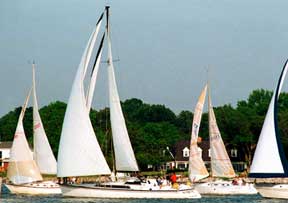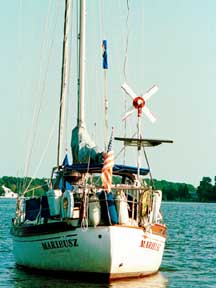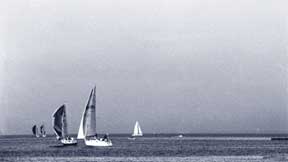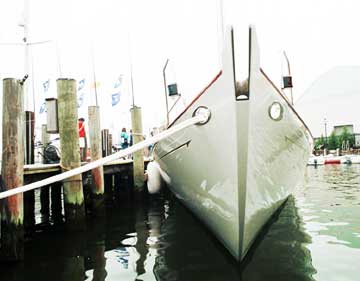 Wind, Water and Sun Sustain Sailors
Wind, Water and Sun Sustain Sailors
Story & Photos by Scott Dine
The vice president of the United States has said that energy conservation is a “virtue” but not the solution to energy problems. He should spend a few days on a sailboat.
Electricity is in short supply on a sailboat, a sort of mini-California whose skipper is constantly trying to figure where the next watt will come from.
And no wonder. Sailboat engines are used for getting in and out of the harbor and slip. A plastic cloth hauled up a stick planted in the middle of the boat does the work of getting across the Bay and beyond. Indeed, sailors can’t wait to turn their engines off. Sailing is not about speed and noise. Much of the enjoyment involves the sound of wind in the rigging, the sound of water moving along the hull.
Engines in powerboats run constantly. No news there.
Engines in powerboats have attached generators or alternators enabling constant replenishment of batteries. No news there, either.
Skippers of sailcraft large enough to cruise the Bay yet small enough to have outboard engines for power must be electrical conservationists. Boats of that ilk are, roughly, 19 to 25 feet in length. Battery power often comes from a charger operated while the boat is docked. Or the skipper removes the battery and takes it home for charging.
We had sailing friends on a lake in the Midwest, owners of a 25-footer. They were also football fans. On a Saturday night, anchored in a pleasant cove, they mounted a small (very small) television set on the top of the coach house and settled back in the cockpit to watch their favorite team trounce the enemy. The screen was not much bigger than a pack of cigarettes. The device was, appropriately, plugged into a cigarette lighter socket.
There our friends sat, under a harvest moon, watching a pixel-sized football move back and forth on the screen. The moon went down, the sun came up and the boat battery died. Life is tough on a sailboat when the crew can’t play the tape deck. The weekend ended. The battery went home for a charge.
Imagine ending a pleasant fall weekend by removing a 35-pound lead-acid battery from your boat’s locker, lifting it onto the dock, then hauling it to the car. Ain’t boating fun?
Boating, hopefully, is about getting away from it all, leaving the rip and the rap ashore along with the television set. We once asked about amenities available for overnight mooring at a certain marina and were told “They have cable television …” Cable television is first on the list of amenities? Have we forgotten that one of the greatest reality shows is a beautiful sunset?
After the sun goes down, a decent power source is a fair request for the cruising sailor. Flashlights are fine for looking in the nooks and crannies of a cockpit locker, but not for reading, or preparing a late meal. And electric lights are much safer than lanterns fueled by oil. A happy sailor has sufficient power to remain independent for a few days.
Self-sufficiency in a sailboat begins with the wind. Every skipper learns how to cope with a headwind blowing from the precise direction of the planned destination. How to keep sailing electric without losing the charge is just another kind of self-sufficiency.
 How Much is Enough
How Much is Enough
To achieve that self-sufficiency, cruising skippers would be wise to sit down and figure out just how much electrical power is needed.
Battery capacity is rated in volts and amp-hours. An 80-amp-hour, 12-volt battery will allow a one-amp light to burn for 80 hours, or three and one-third days. A boat’s basic use of electricity will consume a little more than one-third of an 80-amp-hour battery after a single day, for a total 34 of amp-hours electricity. (See sidebar.) This calculation is bottom line. Using a GPS all day (eight amp-hours) and a depth sounder (four amp-hours) adds to the battery drain. Adding a second battery will be some help, possibly even a necessity.
A generator on the smallest in-board diesel engine running at 2,500rpm produces about 70 amp-hours of electricity, less at lower rpms. Just to replace the basic electricity (34 amp-hours, above) used in 24 hours, the engine will need to run for 30 minutes.
Running back to a marina each night to get juice takes a lot of fun out of cruising.
 Wind to the Rescue
Wind to the Rescue
But there are ways to maintain batteries and independence. Three forces that have been around since creation — sun, wind and water — can be harnessed to do the job.
How? The sun is beamed into a solar panel. The wind blows a fan attached to a generator. Since the sun doesn’t shine all the time and the wind doesn’t blow all the time, some sailors use both solutions.
Most marine retailers offer both solutions. West Marine’s catalog devotes three pages to solar panels and a single page to one wind generator from AIR-X Marine. It’s a generator more aeronautical than nautical in appearance. A three-bladed propeller is attached to the front; a tail drooping at the stern like a spade rudder is indeed a rudder, helping to steer the device into the wind. The generator sits on a nine-foot aluminum “tower,” as described in catalogs and on the AIR-X web site. The tower turns out to be a rather stout pole. Most sailors install this on deck near the stern.
Wind generators begin to manufacture electricity in realistic quantities when wind speeds rise to about seven knots. Beyond 35 knots, most units must be turned off. They can overheat and overproduce replacement electricity for a battery, thus ruining the battery. Each time wind speed doubles, energy available cubes. Wind machines will vary according to construction. AIR-X claims to produce 1.6 amp-hours in a 15-knot wind and 25 amp-hours in a 26-knot wind.
Cheap it is not: the Air-X base price is $899, plus $199.99 for the tower and $189.99 for a mounting kit and sound absorbers. Let’s call that price sticker shock.
Sound absorbers? Noise must be a big complaint about these devices as The West Adviser points out, on page 583 of their catalog: “many cruisers find the noise the blades produce at high wind speeds is very annoying.” (The West Adviser in the West Marine catalog discusses pros and cons of virtually every type of device the company sells.) Stand near a helicopter or one of those small prop-driven commuter airplanes that look like flies in the ointment of a large airport. The noise you hear is not the jet turbine that drives the copter rotor and the airplane propeller. The helicopter rotor blades and airplane propellers pushing air make the noise.
Sailboat rigging pushing through a strong breeze composes a windsong. Propeller noise is simply noise.
The sight of such a device mounted on a sailboat is a bit off-putting to some. Aesthetically it may work better on one of those power yachts that look more like space ships than boats. And the device is not small: propeller blades for catching the wind and driving the generator span five feet on some models. These devices work best in winds that are seven miles per hour and above. The engineers didn’t spend much time on the Chesapeake in August.
Hot Wire Enterprises, distributor of the KISS (Keep It Simple, Sailor) wind generator has an insightful web page, pointing out that the generator can be “shut down in galeforce winds by use of an on-off switch. The switch eliminates the need to approach the wind generator while it is operating.” The KISS device, designed and manufactured in Trinidad, costs $995.
Hot Wire’s web site notes that they will have their “KISSmobile” at Annapolis for the U.S. Sailboat Show October 5 through 7. A blurry photograph of the KISSmobile appears on the Hot Wire web page. It is an elderly Toyota pick-up with a camper bed, a KISS wind generator mounted on the roof of the camper. The camper is probably eight feet high, with the generator adding another five feet. We trust Hot Wire’s drivers will watch out for low bridges on their trek to Annapolis from their base in Madeira Beach, Florida.
Another wind generator issue is vibration. Proper mounting of the generator must include damping. KISS employs thick rubber mounting pads and advises the customer using a pole mount to place it on an aft corner of the deck. The junction of the deck, topsides and transom will be less likely to vibrate. Mounting the generator on the expanse of foredeck creates a speaker-like effect. The best mount, according to an e-mail from KISS signed by “Libbie,” is a solidly anchored stern arch.
Too much wind speed, and the generator overcharges batteries and becomes dangerously hot. Too little wind speed, and the charge supplied is virtually nil.
West Marine Annapolis sells three or four wind-generating units each year, according to assistant manager Fred Wagner. He, too, emphasizes the need for sufficient wind to make generators work. Most buyers are owners of large cruising sail boats headed for the Caribbean, according to Wagner.
Technology will advance and improve as time passes: Desktop computers, fossil-fuel engines, radios have all changed in size and efficiency as technology advances.
 Solar Sufficiency
Solar Sufficiency
Solar panels may be the answer to our Canadian friend who spends considerable time on Georgian Bay, a sailor who brags that his only electrical use, less than one watt, is for his Loran — which he only uses to verify position or in bad weather. His 27-footer has an inboard engine, a one-cylinder job with a generator that barely replaces battery energy used to start the engine. He carries a stack of flashlights and batteries and another stack of candles. His anchor light is fueled by oil. He often cruises up Georgian Bay far from civilization, staying a week at a time. Wind generators with five-foot blades seem very out of place on his small vessel. Those blades would equal 20 percent of the overall boat length. Still, electricity is certainly safer than candles and oil-fueled lanterns.
Our Canadian friend is not trying to be frugal or overly macho. Such amenities as marinas, ice and electricity to charge batteries don’t exist on much of his cruising area. He has learned to be self-sufficient.
Here on the Chesapeake there is hardly more than a few hours of sailing between marinas. What the solar panel will do is replenish reasonable use of battery power. Reasonable replenishment would enable a Chesapeake sailor to stay several nights away from civilization, spending, say, a night on the Rhode River, the next night on the Wye River.
The solar or photovoltaic panel may be the best bet for Chesapeake sailors. Still, it has its drawbacks. Efficiency is based on the amount of sunlight and the temperature. Getting the most of the sun requires cloudless skies with the solar panel pointed directly to the sun.
The most effective solar panels are called monocrystalline, reflecting their construction. The next most effective, called polycrystalline, are less expensive and less efficient. Siemens Solar Industries monocrystalline panels begin at $189.99 for a 3.7 amp-hour-per-day panel to $749.99 for a 33.6-amp-hour-per-day panel. Both versions are covered with glass. Glass breaks. Watch where you drop your winch handle.
A third version of the solar panel, a thin film panel, has about 50 percent of the efficiency of the same size monocrystalline panel. It is not glass-covered, and some versions are flexible. Prices of the panels vary according to output desired. A 1.9 amp-hour per day panel made by Uni-Solar costs $129.99.
Solar panels have their drawbacks. Some models need a regulator to keep the unit from overcharging. There is a general acceptance that an unregulated panel should not produce more than 1.5 percent of the battery capacity in ampere hours. When the sun ducks under a cloud and after sunset, some panels permit a reverse flow of electricity, thus taking out at night what was stored during the day. A diode eliminates this problem.
Energized by Water
Water-powered generators, trailed behind the boat on a cable, are another alternative. But the propeller and generator housing sink to as much nine feet below water surface. Sailboats don’t have sufficient speed to make them work efficiently. Water-powered devices are also literally a drag: They offer as much as 50 pounds of resistance to the boat.
One of a few companies marketing water generators, Salt, Inc., claims theirs will produce two amps of power while cruising at three knots, 10 amps at six knots cruising speed. The device is towed on a cord, the same cord that carries the freshly generated electricity back to the boat and its battery. In a six- or seven-knot wind, the company recommends an 80-foot cord. The propeller on the water generator is eight inches in diameter.
Thus a sailboat equipped with such a generator is trailing what may appear to be a rather large piece of fishing tackle known as a spinner. One cannot help but wonder if a rather large fish might be attracted to such a device.
Fish-luring or not, the spinner will stay down better if the standard plastic model is replaced with a spinner made of brass. Diving planes are available, too, for sailing faster than seven knots. Salt Inc. claims its device may be easily converted to a wind generator.
Virtue Is Its Own Reward
For the Bay sailor, the best bet is probably a second battery and a solar panel for easy maintenance. Wind generators are intended for greater wind velocity than the Bay receives. Water generators work best at boat speeds of five knots or better, and it does seem silly to drag an 80-foot extension cord around Chesapeake Bay, a body of water whose depth averages 15 to 25 feet.
But the Bay opens into the wide world, where wind and even water can help keep a sailor self-sufficient.
Calculating Your Boat’s Electricity Consumption
Battery capacity is rated in volts and amp-hours. An 80-amp-hour, 12-volt battery will allow a one-amp light to burn for 80 hours, or three and one-third days. Start by calculating your boat’s basic electrical consumption, such as running and anchor lights, stereo, GPS and other electronics.
- Device Rating
- Anchor light 1.0 amp
- Mast head light 1.7 amps
- GPS 0.5 to 1.0 amp
- Running lights 1.0 amp/light
- Depth sounder 0.1-0.5 amp
- Stereo/tapedeck 1.0 amp
- Cabin reading /work lights 1.5 amps
Next figure the daily power requirements, the amount of electricity you’ll need anchored for the night, say, in the Rhode River.
- Device Rating Hours use Total load
- Anchor light 1.5 amps 8 12 amp-hours
- 4 reading/work lamps 1.5 amps each 2 each 12 amp-hours
- Radio/cassette player 2 amps 5 10 amp-hours
- Total Amp Hours Used 34 amp-hours